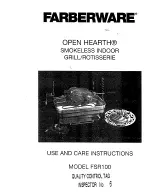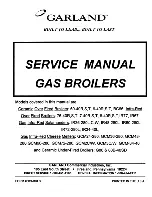
95
E. After Maintenance is Complete
Functional Test
After maintenance is complete, ensure the CH circuit is filled and
purged with a pressure of 12 psi. Ensure the DHW circuit is filled and
purged.
1. Power the boiler on.
2. If necessary, purge air again from the CH and DHW circuits.
3. Check the boiler and system settings and components. Ensure all
adjustments are working properly.
4. Ensure the exhaust pipe is connected properly.
5. Reinstall the boiler front cover.
6. If necessary, set the maintenance interval.
Inform the User
1. Inform the user of any changes / adjustments / replacements in the
system.
2. Ensure the user understands how the system works.
3. Hand the instructions to the user. Ensure the instructions will be
kept close to the unit.
4. Have the user perform these regular tasks:
• Check the system water pressure regularly.
• If necessary, restore pressure and vent the system.
• Set the setpoints and control systems to ensure correct and
economical control of the system.
• Have the system serviced in accordance with regulations at
regular intervals.
• NEVER attempt to service the boiler or adjust the combustion
system.
Part 15 - Maintenance Report
The boiler requires minimal periodic maintenance under normal
conditions. However, in unusually dirty or dusty conditions, periodic
vacuuming of the cover to maintain visibility of the display and
indicators is recommended.
Periodic maintenance should be performed once a year by a qualified
service technician to ensure that all the equipment is operating safely
and efficiently. The owner should make necessary arrangements with
a qualified heating contractor for periodic maintenance of the boiler.
Installer must also inform the owner that the lack of proper care and
maintenance of the boiler may result in a hazardous condition.
CAUTION
In unusually dirty or dusty conditions, care must be taken to
keep boiler cabinet door in place at all times. Failure to do
so VOIDS WARRANTY!
WARNING
Allowing the boiler to operate with a dirty combustion chamber
will hurt operation. Failure to clean the heat exchanger as needed
by the installation location could result in boiler failure, property
damage, personal injury, or death. Such product failures ARE NOT
covered under warranty.
The combustion chamber insulation in this product contains
ceramic fiber material. Ceramic fibers can be converted
to cristobalite in very high temperature applications. The
International Agency for Research on Cancer (IARC) has
concluded, “Crystalline silica inhaled in the form of quartz or
cristobalite from occupational sources is carcinogenic to humans
(Group 1).”
• Avoid breathing dust and contact with skin and eyes.
•
Use a NIOSH certified dust respirator (N95). This type of
respirator is based on the OSHA requirements for cristobalite
at the time this document was written. Other types of
respirators may be needed depending on job site conditions.
Current NIOSH recommendations can be found on the NIOSH
website: http://www.cdc.gov/niosh/homepage.html. NIOSH
approved respirators, manufacturers, and phone numbers
are also listed on this website.
•
Wear long-sleeved, loose fitting clothing, gloves, and eye
protection.
• Apply enough water to the combustion chamber lining to
prevent dust.
• Wash potentially contaminated clothes separately from other
clothing. Rinse clothes washer thoroughly.
NIOSH stated First Aid.
• Eye: Irrigate immediately.
• Breathing: Fresh air.
Summary of Contents for FTVN
Page 98: ...98 Maintenance Notes...






































